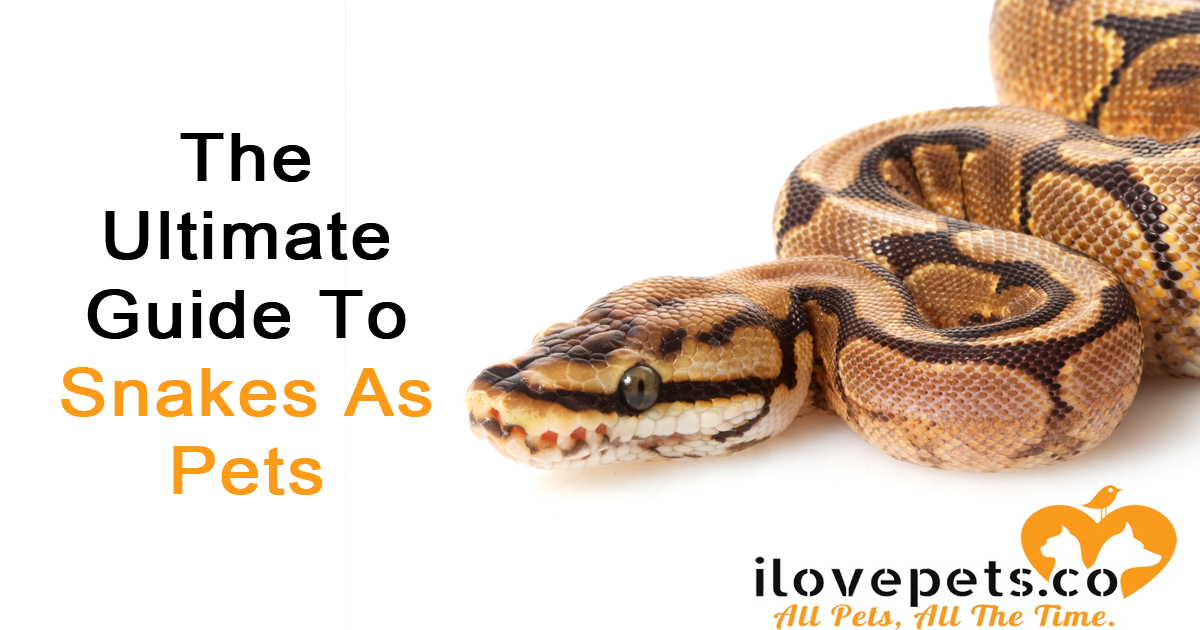
A snake is an independent, low maintenance pet that won’t bark, whine, cry or destroy your home. They are fairly inexpensive to keep, requiring only an upfront investment for a proper enclosure and possibly heating and lighting.
It’s fun to handle a snake and allow it to slither over your body. Snakes enjoy exploring their surroundings. You’ll love watching your curious reptile hang out outside their cage a few times each week.
Snakes are also relatively clean. Since they eat weekly, they poop weekly, so you never have to worry about housebreaking or litter boxes. Their enclosure can be cleaned monthly, with regular spot cleaning to keep their tank fresh.
Types Of Pet Snakes
Ball pythons are one of the most common types of pet snakes. They come in many colors and patterns, known as morphs, and females are 3-5 feet long, males, 2-3 feet in length. Ball pythons are typically shy and require moderate humidity in their enclosure. The Ball python gets its name from its unique defense mechanism; when scared, it curls up into a ball.
Corn snakes are also very common as pets, and, like ball pythons, come in many morphs. They grow to be 4-5 feet in length.
California King Snakes typically have black and white striped markings. They grow to be 3-4 feet in length. The California King snake got its name because it is known to eat other snakes in the wild, though your pet will happily eat mice.
Garter snakes are a small, common species, making them great for beginners. Adults grow to be just 2-3 feet long.
It’s not ideal to keep a snake that you find in your garden or elsewhere outdoors. Wild snakes may never get used to handling, and they tend to carry parasites and have other health issues. You can purchase a captive born snake at a pet store, reptile expo, from a breeder or a rescue or on PetFinder.com. It’s rare to find a snake in an animal shelter, but it wouldn’t hurt to ask.
Feeding Your Pet Snake
A mouse or rat is a complete, balanced meal for a snake. You don’t need any other food or supplements for most adult snakes.
You’ll need to choose prey that is no larger than the girth of the thickest part of the snake. You can find different sizes of prey at most pet stores. “Pinkies” are hairless, newborn mice or rats, appropriate for hatchlings. “Fuzzies” or fuzzy mice/rats are slightly older than pinkies, and “hoppers” are a bit older than fuzzies.
Some owners choose to feed live prey. You could raise mice to feed to your snake. Mice are inexpensive to raise and breed every few weeks, so you’ll always have enough food for your snake. You could also purchase live mice or rats at a pet store. However, sometimes snakes are not hungry or don’t kill their food quickly, so their prey could strike back, causing injuries.
It’s best to feed frozen prey to your snake. That way, you can always keep extras in your freezer and you won’t have to worry about prey bites.
You can feed your snake every 7-12 days, though some go even longer between meals. Ball pythons are known for being finicky and may refuse meals. Snakes eat even less frequently in the winter. As long as your snake appears healthy, it’s okay to allow them to decide when they want to eat.
Do not handle your snake for 48 hours after feeding. When snakes are stressed, their digestion stops and they regurgitate their food.
Your Pet Snake’s Enclosure And Furnishings
An aquarium makes a good home for most small-to-medium sized snakes. A 20-gallon tank works for a garter snake; most other species need 30-40 gallon tanks.
You’ll need to cover the floor of the aquarium with a substrate. Newspaper, sand, cyprus mulch or aspen bedding can be suitable.
A hiding spot is essential for reducing stress in snakes, particular shy ones like the ball python. A cardboard box with holes can work, or you can shop around for attractive furnishings.
Snakes are cold-blooded, so they will die if their enclosure is not warm enough. The optimal temperature depends on your species of snake and the climate of their origin country. Use a heat lamp and a tank thermometer to keep your snake warm, usually around 75 to 80 degrees Fahrenheit for most species.
You’ll need to provide fresh water in a wide, shallow bowl. The bowl should allow the snake to slither in and soak if they choose. Snakes tend to soak in water when they’re shedding to help loosen their outermost layer of skin.
How Snakes Interact With Their Owners
When you choose a snake as a pet, you know you’re not going to get the love and affection you would from a cat or a dog. Even so, snakes do distinguish their owners from other people based on scent. Some may react when their owner is near, especially at mealtimes.
Picking up and handling your snake is generally stressful to them. Your snake might not mind being stroked and might enjoy your body heat. For the most part, you’ll find it easiest to enjoy your snake by allowing them to spend time near you.
Just Snake Things
While snakes do not shed fur all around your home, they do shed their skin a few times each year. Baby snakes may shed every few weeks as they outgrow their skin.
Snakes continue to shed their skin throughout their lives because they actually never stop growing. They only slow down as they get older.
Most species of snakes can live to be at least 15 years old. Some can live to be over 40. Owning a reptile is as much a commitment as any other animal, though they need very little to be content and healthy for many years.
Have you ever owned a snake? Tell us about them in the comments!







Snakes can be wonderful, low maintenance pets. They’re not for everyone though. If you want something to cuddle, get a dog.